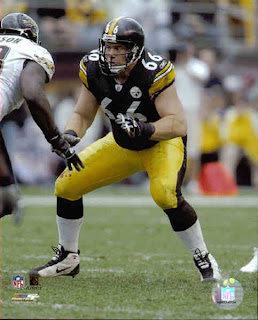
Friday, August 31, 2007
By Ron Cook, Pittsburgh Post-Gazette
CHARLOTTE, N.C. -- Nine days to go.
To when the Steelers open the regular season in Cleveland, sure. But also to management's self-imposed deadline to sign guard Alan Faneca to a new contract.
There's still time to get a deal done, you know?
Both sides owe it to the other to make one final try.
If this extra long preseason -- which ended happily for the Steelers last night because no significant players were injured in their 19-3 win against the Carolina Panthers -- revealed anything, it's that the team needs Faneca, not just for this season but for beyond. Quite simply, he remains their best offensive lineman. Forger that sack he allowed to Carolina defensive tackle Kris Jenkins in the only series he played. It happens. Actually, it happened exactly the same way two years ago in the final exhibition game; Jenkins blew by Faneca, who was left to pick up quarterback Ben Roethlisberger and tell him he was sorry. Roethlisberger survived. Faneca went on to another Pro Bowl season. The Steelers went on to win the Super Bowl.
It's nice to think the same thing could happen again this season.
There also could have been mitigating circumstances involved in that sack last night. If Faneca's head wasn't in the game, who can blame him? None of the players wanted to play -- their only goal was to get out in one piece -- but he had the added burden of knowing his future with the Steelers is about to be officially determined. The team doesn't negotiate contracts during the season, and Faneca surely will go to the highest bidder if he becomes a free agent after the season.
It doesn't have to go down that way. Really.
"Nothing's happening," Faneca said, shaking his head, when asked if the two sides had reached out to each other or at least have plans to do so. "Nothing's scheduled."
That's OK, it only takes one phone call.
The Steelers need to raise their offer to Faneca. His value to the team only increased this summer, the way new coach Mike Tomlin shuffled linemen in and out of the exhibition games, looking for five starters. It appears center Sean Mahan, right guard Kendall Simmons and right tackle Willie Colon have won jobs, but Tomlin hasn't made it official. Only Faneca at left guard and Marvel Smith at left tackle are rock-solid as starters. That's unsettling, to say the least.
As former Steelers running back Jerome Bettis noted on more than one occasion in his new book, which created so much buzz around town last week, Steelers management not only is hesitant to give big contracts to players older than 30, it starts to look for reasons to get rid of them. Faneca will be 31 before the end of the season, but he's a little different than most older players. For one thing, he's a six-time Pro Bowler, the most-honored guard in franchise history. For another, he's not like a running back or wide receiver or most defensive players. His game isn't based on speed. There's reason to think he still will be effective and able to play at a high level for several seasons. Durability hasn't been a concern to this point; he has missed only two games in his nine NFL seasons, none since 2001.
But Faneca also needs to be reasonable and bring his price down a bit. He can't expect to get the same money now that he would as an unrestricted free agent after the season, not with this year still remaining on his current contract. What he can get, though, is peace of mind and security for his family. If he does a new deal with the Steelers, he won't have to worry about a serious injury sabotaging his future. He already will have cashed that big signing bonus check and won't have to give a cent back.
There has been much speculation since Faneca's infamous minicamp rant in May that he's too bitter to do a new contract with the Steelers. That's nonsense. The man isn't stupid. He'll forget his bitterness real quickly if the Rooneys offer the right money. For their part, they certainly won't hold a grudge because of anything he said out of frustration. This isn't personal, it's business.
The Post-Gazette's Ed Bouchette is reporting today that the Steelers have stepped up efforts to re-sign Simmons, who also is entering the final season of his contract. That's fine, but Faneca is the man they should be targeting.
It's not too late.
First published on August 31, 2007 at 12:06 am
Ron Cook can be reached at rcook@post-gazette.com.























